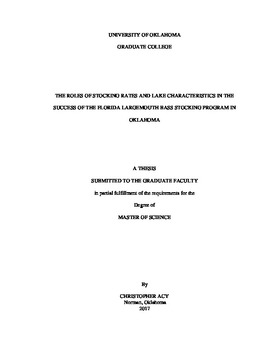| dc.description.abstract | Florida largemouth bass, Micropeterus salmoides floridanus (Lesueur 1822), have been introduced throughout the United States in an effort to improve trophy bass fishing appeal by increasing fish size and number. However, there are conflicting results as to whether pure Florida largemouth bass and first generation Florida-northern bass hybrids (F1) actually grow larger and faster than native largemouth bass Micropterus salmoides salmoides, hereafter northern largemouth bass. The Oklahoma Department of Wildlife Conservation (ODWC) has stocked mainly Florida largemouth bass in Oklahoma lakes for over 30 years. The 3400 Heating Degree Day (HDD) isocline has served as the main criterion for determining which lakes should be stocked with Florida largemouth bass with stocking occurring primarily in warmer lakes to the south and southeast of the 3400 isocline. Using an eight-year data set of microsatellite-based genotypic verification in largemouth bass collected from lakes around Oklahoma, as well as six environmental characteristics of lakes and stocking parameters, I assessed: 1) ) if stocking effort and general lake characteristics can explain the success of the Florida largemouth bass stocking program as measured by the frequency of Florida alleles in Oklahoma lakes; and 2) whether the lakes that are producing the largest trophy bass in Oklahoma have higher frequencies of Florida alleles compared to non-trophy bass lakes. Stocking effort was quantified using the currently (since 2013) employed ODWC tier system with tier one lakes having the highest stocking effort, as they are stocked the most frequently and receive the highest number of Florida largemouth bass fingerlings. Quantity and frequency of Florida largemouth bass stocking decreases in tiers two (fewer fingerlings at lower frequencies) and three (fry at very low frequencies). I also examined total number of Florida largemouth bass stocked in each lake since 2009 in order to capture longer term impacts that may not be apparent since the 2013 tier program began. Differences in the effect of stocking effort were observed in hybrid cross bass (FX) and total bass with at least one out of the three measured Florida largemouth bass alleles (TBFA). There was little variation observed for FLMB and F1 genotypes. Ninety percent of fish sampled had at least one Florida allele indicating that Florida alleles are remaining in bass populations in Florida largemouth bass stocked lakes. Regularized linear models identified that total number of stocked Florida largemouth bass had a positive effect on predicting the highest frequencies of FLMB, F1, FX, and TBFA. No differences were detected on genotype or TBFA between trophy and non-trophy lakes. Because nearly every fish examined since 2009 had at least one Florida allele, and the total number of fish stocked since 2009 explained the most success in the bass stocking program, the ODWC could probably begin focusing effort toward other lakes (e.g., tiers two and three). However, there remains substantial uncertainty in the roles of lake characteristics, and the potential influences of natural and fishing-induced mortality, as well as the ecological ramifications of stocking Florida largemouth bass on the overall ecology and food-web stability of stocked lakes, particularly due to the uncertainties introduced by the ever changing climate conditions. | en_US |
